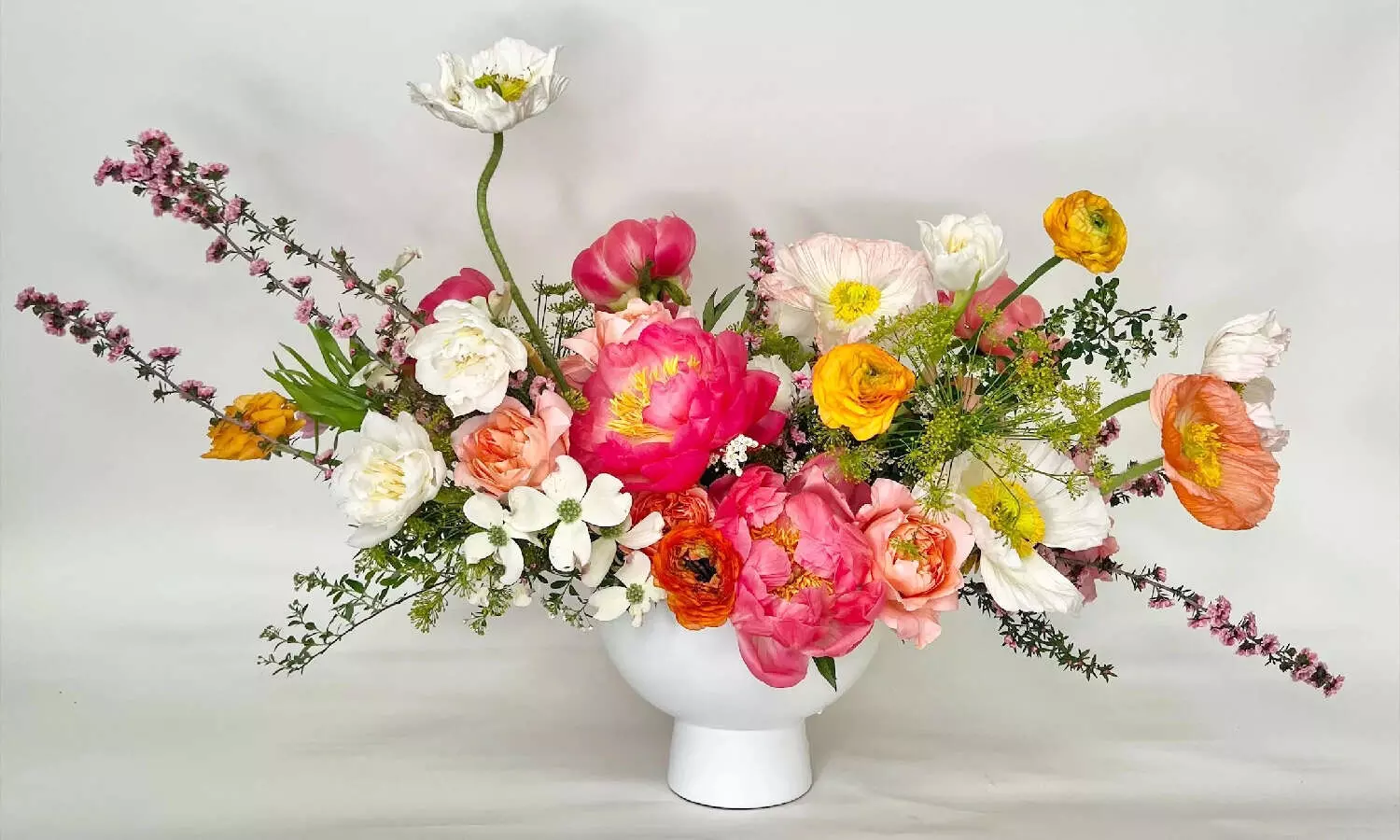`Not all flowers behave same once they dry’: Here are some creative, eco-friendly possibilities
Not all flowers behave the same once they dry. Hardy varieties tend to have a longer afterlife.
By Newsmeter Network
Hyderabad: Fresh flower arrangements brighten homes, events, and workspaces, but once the blooms begin to fade, most people simply throw them away.
Florists and sustainability experts say that the life of flowers can continue long after an arrangement has wilted, offering practical, creative, and eco-friendly possibilities.
“A flower’s value doesn’t end when the vase life ends. It only changes form,” says Rhea Matthan, floral designer, speaking to Newsmeter. “A single bouquet can be repurposed into art, compost, skincare, or home fragrance if you handle it correctly.”
Selecting Blooms That Can Be Repurposed
Not all flowers behave the same once they dry. Hardy varieties tend to have a longer afterlife.
Best flowers for drying or reuse:
• Roses
• Carnations
• Chrysanthemums
• Lilies (petals only)
• Hydrangeas
• Statice
• Baby’s breath
• Marigolds
According to floral preservation specialist Neelam Arora, “Flowers with thicker petals retain shape and colour better. Thin, delicate petals collapse quickly and are better suited for potpourri or compost.”
Drying Flowers for Long-Term Keepsakes
Drying is the most common way to extend the life of flowers. There are three primary methods:
1. Air-Drying
Hang small bunches upside down in a dark, dry room for 3–4 weeks.
Ideal for roses, lavender, and baby’s breath.
2. Pressing
Place petals or whole blooms between sheets of paper under a weight.
Good for journaling, bookmarks, and frame art.
3. Silica Gel Drying
Used by professional preservationists to retain almost-original colour.
Works well for intricate flowers like peonies or orchids.
Arora notes, “Drying flowers is more about patience than technique. If you rush the process with heat, the petals become brittle and lose colour.”
Home Fragrance Uses: Potpourri, Sachets, Oils
Once dried, flowers can be used to subtly fragrance living spaces.
Potpourri
Mix dried petals with whole spices like cinnamon and cloves. Add a few drops of essential oil.
Keeps for months and refreshes easily.
Drawer and Wardrobe Sachets
Place dried lavender, rose petals, or marigolds inside small cotton pouches to keep clothes smelling fresh.
Infused Oils
Petals from roses or calendula can be soaked in carrier oils such as almond or jojoba.
These mild floral oils can be used on skin, hair, or for aromatherapy.
“Flower-infused oils carry gentle properties without synthetic fragrance. They work well for people sensitive to strong perfumes,” says aromatherapy practitioner Dr. Reetika Anand.
Creating Natural Dyes
Flowers like marigold, hibiscus, and rose can be boiled to create plant-based dyes for fabric, paper, or crafts.
Basic Method
1. Simmer petals in water for 30–45 minutes.
2. Strain and cool.
3. Dip small fabric swatches for light tinting.
Marigolds produce yellow-orange hues, hibiscus gives a pinkish-red tone, and roses yield a soft blush dye.
Craft educator Sanjay Iyengar says, “Natural dyes may fade over time, but they offer a chemical-free way to colour small projects, especially for children or hobbyists.”
Using Flowers in Skincare and Bath Rituals
While not all flowers are skin-safe, some can be repurposed for mild personal-care uses.
Bath Soaks
Dried rose, chamomile, and calendula petals can be added to warm bath water or foot-soak buckets.
Floral Steam for Skin
Add petals to hot water and use the steam to open pores.
Avoid flowers treated with heavy sprays or chemicals.
Simple Floral Water
Simmer petals in water for 10 minutes and strain.
Use as a linen spray or room mist (not for long-term storage).
Dr. Anand warns, “Never apply random flower extracts directly on skin. Stick to known-safe flowers and rinse after use.”
Crafts and Home Décor Projects
Dried flowers can be turned into long-lasting decorative elements.
Pressed Flower Art
Frame pressed petals or whole blooms for minimalist wall art.
Candle Embedding
Dried petals can be attached to the outer surface of candles using melted wax.
Ensure petals are completely dry to avoid mold.
Resin Keepsakes
Embedding petals in clear resin can create coasters, jewellery, or decorative blocks.
Best suited for wedding bouquets or memorial arrangements.
According to Matthan, “People now want memory-based décor, a way to preserve the sentiment connected to flowers. Resin and framed art are among the most requested formats.”
Culinary Use: With Caution
Only edible flowers should be used in food. Roses, pansies, marigolds (calendula), lavender, and hibiscus are generally safe when organically grown.
Possible Uses
• Rose petal syrups
• Hibiscus tea
• Lavender sugar
• Marigold salad toppings
Food stylist Meghna Kapoor advises, “Use petals from pesticide-free arrangements only. Never consume flowers from unknown sources or commercially dyed bouquets.”
Composting: The Most Sustainable End
When flowers can no longer be dried or reused, composting becomes the best option.
Petals break down quickly and enrich the soil with trace minerals.
How to Compost Flowers
• Remove plastic wraps, wires, or foam.
• Chop stems into smaller lengths.
• Mix with kitchen waste and dry leaves.
Composting expert Anish Babu says, “Flower waste is soft, nitrogen-rich material. It balances well with dry carbon waste and helps maintain compost moisture.”
Religious and Community Uses
In many cities, temples and community groups collect used flowers for recycling into incense sticks, organic colours, and compost.
Municipal waste volunteer Sharada Mohan explains, “Flower waste is one of the cleanest biodegradable categories. When segregated properly, it can be reused by several community enterprises.”
Final Word
Flowers have a life beyond the vase. With simple practices, drying, crafting, composting, scenting, or infusing, households can reduce waste and continue to enjoy flowers in new forms. As Matthan summarises, “If you think of flowers as material instead of waste, you realise they can serve many purposes even after the arrangement is gone.”